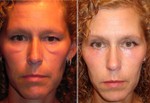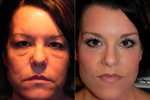As we age, changes occur in the areas around our eyes. Fullness can occur in both the upper eyelid and the lower eyelids. This fullness can make a person appear tired, sick or old to other people. Many people with these changes often hear comments like, “You look tired. Are you OK?”
You may feel fine, but hearing you look tired can affect you psychologically—and it can be frustrating to hear you look tired when you’re feeling just fine.
As a result of these aging changes, many people seek surgical help for their condition.
There are some fine points that need to be taken into account before considering upper or lower eyelid surgery.
The Upper Eyelid
The upper lid is framed above by the eyebrow. The aging process often affects both the upper lid and eyebrow simultaneously—i.e. the brow gets lower and the upper lid gets heavier with age.
As a result, many people with heaviness above their upper lid will raise their brows upwards unconsciously to un-encumber the upper lid area. This does allow the heaviness to be lifted in part from the upper lid area, but it can produce lines in the forehead.
Lifting the brows upwards allows the heaviness to be lifted, but it can produce lines in the forehead.
Often when the brow is relaxed, the heaviness returns to the upper lid region and the brow is seen to be much lower than normal.
This can often be seen in photographs because when we smile, we relax many of the muscles in the face. The brow—which is being artificially raised—relaxes and our photos can then show extra heaviness in the upper lid area.
In a case like this, it’s actually a mistake at times to address only the upper lid heaviness with an upper eyelid surgery or Blepharoplasty. This is because if the eyebrow is actually low in its natural position and the impetus to raise the brows is removed by taking the upper lid heaviness away, the brow often relaxes back into and crowds the upper eyelid space.
It’s as if the brain breathes a sigh of relief and says, “Whew! Now that the upper lid heaviness has been removed, we no longer need to pull up the brow all day long.” At this point, the brow—which was being artificially raised up—comes back to its normal low position and seems to recreate the heaviness that was just corrected with the upper eyelid surgery.
So the first thing to recognize when considering upper eyelid surgery or Blepharoplasty is that the eyebrow needs to be assessed and taken into account. Sometimes correcting the eyebrow first can greatly reduce the need to perform any upper eyelid surgery at all.
The Lower Eyelid
Often the aging process in the lower eyelid region affects not only the fullness of the lower eyelid area, but the overlying skin as well.
On one hand, the skin in the lower eyelid can become “crepey”; while on the other hand, swollen mounds can form in the lower eyelid and cheek region, known as Festoons or malar mounds. The lower eyelid fullness is due to fat changes around the lower eyelid, while the skin changes and Festoons/malar mounds are often due to sun exposure over the years.
If these skin issues aren’t corrected at the same time and only the lower eyelid fat changes are addressed, the results can actually look worse afterwards. This is especially true when malar mound and eyelid Festoons are present.
Example: After lower lid surgery but before treating Festoons
There are some deep-set reasons for this.
Our brain is constantly evaluating another person’s face for non verbal clues. This is why a person with “bags” under the eyes is often told they appear tired. Lower lid bags often do occur with “crepey” skin on the lower eyelid and Festoons malar mounds on the cheek region. When both bags and Festoons are present, the brain sees them as belonging naturally together as a sign of aging.
If just the lower eyelid bags are corrected but not the Festoons and malar mounds, the brain sees something “off” about this situation. It actually makes the area appear more contrasted because with the lower eyelid fullness improved alone, the Festoons and malar mounds appear highlighted and the surgical result can appear worse than the condition before surgery. (See below.)
Festoons and malar mounds are technically difficult to correct, but thankfully a technique I call the Laser RESET® treatment for lower eyelid Festoons and malar mounds can be helpful in improving this difficult condition. For the most natural, balanced results, it’s best to treat both the lower eyelid fullness and Festoons/malar mounds at the same time.
Before and after: Treating eyelid Festoons and malar mounds
Before and after: Treating both lower lid fullness and eyelid Festoons/malar mounds
Before and after: Treating both upper and lower lid fullness and eyelid Festoons/malar mounds
Before and after: Treating lower eyelid fullness and Festoons/malar mounds
In the End
Balance is really the key in both of these conditions. We don’t want to correct part of the problem in each area. We want to correct both parts of the problem in both areas so that we get results that are powerful but subtle and natural at the same time.
For more information on this procedure, and others we perform to help our patients Restore, Reveal and Reclaim their natural beauty, please contact us.








